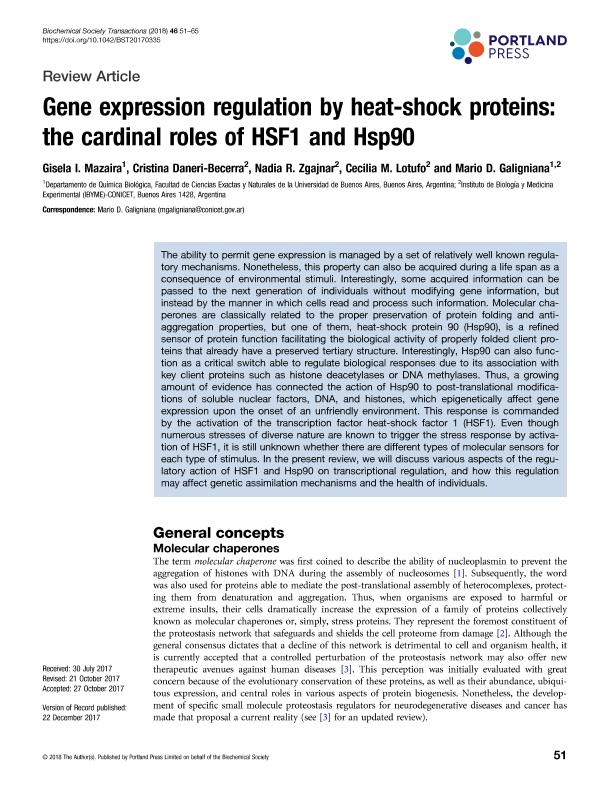Mostrar el registro sencillo del ítem
dc.contributor.author
Mazaira, Gisela Ileana

dc.contributor.author
Daneri Becerra, Cristina del Rosario

dc.contributor.author
Zgajnar, Nadia Romina

dc.contributor.author
Lotufo, Cecilia Maricel

dc.contributor.author
Galigniana, Mario Daniel

dc.date.available
2018-11-05T22:53:16Z
dc.date.issued
2017-02
dc.identifier.citation
Mazaira, Gisela Ileana; Daneri Becerra, Cristina del Rosario; Zgajnar, Nadia Romina; Lotufo, Cecilia Maricel; Galigniana, Mario Daniel; Gene expression regulation by heat-shock proteins: the cardinal roles of HSF1 and Hsp90; Portland Press; Biochemical Society Transactions; 46; 1; 2-2017; 51-65
dc.identifier.issn
0300-5127
dc.identifier.uri
http://hdl.handle.net/11336/63722
dc.description.abstract
The ability to permit gene expression is managed by a set of relatively well known regulatory mechanisms. Nonetheless, such property can also be acquired during the life span as a consequence of environmental stimuli. Interestingly, some acquired information can be passed to the next generation of individuals without modifying gene information, but instead, the manner cells read and process such information. Molecular chaperones are classically related to the proper preservation of protein folding and anti-aggregation properties, but one of them, Hsp90, is a refined sensor of protein function facilitating the biological activity of properly folded client proteins that already have a preserved tertiary structure. Interestingly, Hsp90 can also function as a critical switch able to regulate biological responses due to its association to key client proteins such as histone deacetylases or DNA methylases. Thus, a growing amount of evidence has connected the action of Hsp90 to post-translational modifications of soluble nuclear factors, DNA, and histones, which epigenetically affects gene expression upon the onset of an unfriendly environment. Such response is commanded by the activation of the transcription factor HSF1. Even though a great number of stresses of diverse nature are known to trigger the stress response by activation of HSF1, it is still unanswered whether there are different types of molecular sensors for each type of stimulus. In this article, we will discuss various aspects of the regulatory action of HSF1 and Hsp90 on transcriptional regulation, and how this regulation may impact genetic assimilation mechanisms and the health of individuals.
dc.format
application/pdf
dc.language.iso
eng
dc.publisher
Portland Press

dc.rights
info:eu-repo/semantics/openAccess
dc.rights.uri
https://creativecommons.org/licenses/by-nc-sa/2.5/ar/
dc.subject
Immunophilins
dc.subject
Hsp90
dc.subject
Hsf1
dc.subject
Chaperones
dc.subject.classification
Bioquímica y Biología Molecular

dc.subject.classification
Ciencias Biológicas

dc.subject.classification
CIENCIAS NATURALES Y EXACTAS

dc.title
Gene expression regulation by heat-shock proteins: the cardinal roles of HSF1 and Hsp90
dc.type
info:eu-repo/semantics/article
dc.type
info:ar-repo/semantics/artículo
dc.type
info:eu-repo/semantics/publishedVersion
dc.date.updated
2018-10-23T15:53:59Z
dc.journal.volume
46
dc.journal.number
1
dc.journal.pagination
51-65
dc.journal.pais
Reino Unido

dc.journal.ciudad
Londres
dc.description.fil
Fil: Mazaira, Gisela Ileana. Universidad de Buenos Aires. Facultad de Ciencias Exactas y Naturales. Departamento de Química Biológica; Argentina
dc.description.fil
Fil: Daneri Becerra, Cristina del Rosario. Consejo Nacional de Investigaciones Científicas y Técnicas. Instituto de Biología y Medicina Experimental. Fundación de Instituto de Biología y Medicina Experimental. Instituto de Biología y Medicina Experimental; Argentina
dc.description.fil
Fil: Zgajnar, Nadia Romina. Consejo Nacional de Investigaciones Científicas y Técnicas. Instituto de Biología y Medicina Experimental. Fundación de Instituto de Biología y Medicina Experimental. Instituto de Biología y Medicina Experimental; Argentina
dc.description.fil
Fil: Lotufo, Cecilia Maricel. Consejo Nacional de Investigaciones Científicas y Técnicas. Instituto de Biología y Medicina Experimental. Fundación de Instituto de Biología y Medicina Experimental. Instituto de Biología y Medicina Experimental; Argentina
dc.description.fil
Fil: Galigniana, Mario Daniel. Universidad de Buenos Aires. Facultad de Ciencias Exactas y Naturales. Departamento de Química Biológica; Argentina. Consejo Nacional de Investigaciones Científicas y Técnicas. Instituto de Biología y Medicina Experimental. Fundación de Instituto de Biología y Medicina Experimental. Instituto de Biología y Medicina Experimental; Argentina
dc.journal.title
Biochemical Society Transactions

dc.relation.alternativeid
info:eu-repo/semantics/altIdentifier/url/http://www.biochemsoctrans.org/content/46/1/51
dc.relation.alternativeid
info:eu-repo/semantics/altIdentifier/doi/http://dx.doi.org/10.1042/BST20170335
dc.relation.alternativeid
info:eu-repo/semantics/altIdentifier/url/29273620
Archivos asociados
